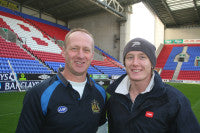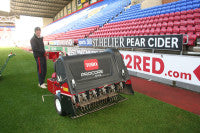Giving the JJB a sporting chance
 Spare a thought for all stadium groundstaff who are now in their most difficult, busiest and worrying time of the year; when pitches are subjected to the most severe test of recovery after matches.
Spare a thought for all stadium groundstaff who are now in their most difficult, busiest and worrying time of the year; when pitches are subjected to the most severe test of recovery after matches.
It's not unusual to hear of clubs having six or seven games within an eighteen day period and a good cup run can add severely to the pressure. And there's also the training and warm up regimes to contend with!
Short days and unusual weather patterns also affect the extent of work that can be achieved. Air and soil temperatures are consistently low which also has an affect on grass growth and recovery rates after matches.
Pitch quality is paramount with regard to its performance and all important results, and that doesn't include the added pressures from owners, managers, players and fans alike.
Grass growth and sward recovery can be, at best, slow or, in many cases, non-existent depending on the type of stadium environment, pitch construction and resources the Groundsman has at his disposal. Lighting rigs, tents, canopies and various under soil heating and air flow systems have helped, but not all clubs can afford such luxuries.
Each Groundsman will have his own maintenance regime which is often governed by the type of pitch he has to manage.
Most Premier League pitches, for example, are predominantly sand or sand/soil based but with different configurations of stabilisation materials. They are reinforced, either by fibres incorporated within the rootzone layer, which can be crimped or elastic fibres mixed into the top 100mm of the profile, or sown into place as with the Desso system.
A Desso pitch is natural grass reinforced with synthetic grass fibres. Twenty million artificial grass fibres are injected 20cm deep into the pitch. During the growing process, the roots of the natural grass entwine with the synthetic grass fibres and anchor the turf into a stable and even field. In this way the natural grass fibres are better protected against ant damage. It also improves drainage.
Whichever system is being employed the performance is influenced by the maintenance it receives over a period of time. Sometimes things go wrong and pitch performance can suffer, as Wigan Athletic Football Cub found out for themselves back in 2003.
The JJB pitch was built using the Desso system back in 1999 and, in the first few years, performed well. However, with the constant demand for use by both the football club and Wigan Rugby League club it was not long before the pitch began to deteriorate.
The combination of over use - the pitch was being used for fifty weeks of the year, which in turn led to compaction, dictated a very small window of opportunity for adequate end of season renovations. In addition, the club did not have all the equipment required to maintain the pitch.
Further improvements were necessary to satisfy the needs of the club's new status in the Premiership. The club purchased a climate tent cover which enabled the groundstaff to work during inclement weather and also helped protect the pitch from adverse weather conditions.
In 2006 Wigan decided to invest in additional equipment to keep the pitch in peak condition. Today, this is almost as important for television producers as it is for the players.
Top of Ian's list was a Verti-Drain 7215. "At the end of last season, there was still a problem with black layer inhibiting the growth of healthy turf" said Ian.
"The Verti-Drain machines helped revitalise the turf, not only by digging deeper, but also by the manner of its 'heave' operation which shatters deep-rooted compaction. This creates extra pore and air space, encouraging drainage, healthy grass growth and beneficial microbial activity."
 "I used the Verti-Drain regularly, choosing different tines to suit the prevailing conditions. I also varied the direction of operation to maximise the benefits and to ensure all areas were treated.""
"I used the Verti-Drain regularly, choosing different tines to suit the prevailing conditions. I also varied the direction of operation to maximise the benefits and to ensure all areas were treated.""
"But, by December 2006 the pitch was showing signs of wear and tear from the heavy playing schedule at such a high level with both sports. We decided that our high Premiership position at the time almost demanded investment in a new surface for the remainder of the season."
"We called in Talbot Landscapes to look at the possibility of returfing the pitch. A fourteen day break in the home fixture list allowed this to happen."
Simon Barnaby, from Syngenta, was brought in to oversee the laying of the new turf. "The surface vegetation was koroed off, re-levelled and relaid with 40mm thick big roll turf with the aim of trying to keep the surface together until the end of the playing season."
"In addition to the regular ongoing weekly maintenance, a programme of aeration was implemented utilising our new Toro Procore and Verti-Drain to maintain some porosity in the top 100-150mm of the pitch profile to ensure that it remained free draining. I was conscious that we needed to promote new root growth that would not only help stabilise the pitch but also provide a key into the existing Desso system."
"By May the pitch was performing really well and we decided to retain the surface for the 2007 season. The overlap of the two sports means that we do not have a traditional 8-12 week renovation window. We just have to do the work when fixtures allow."
This was between May 7th-17th and June 18th-July 3rd. The same programme of work was undertaken on both occasions and involved light scarifying, aeration and topdressing with around 80 tonnes of sand and 20 tonnes of rubber crumb, and overseeding with a Johnson ryegrass seed mix.
"My fertiliser programme is based on a soil analysis of the profile" said Ian. "In 2007 we carried out several applications beginning in the summer with a 15:0:29, followed by 12:0:12 and a 7:0:14 high potassium. Finally a 0:0:37 slow release was applied in the autumn. We also applied Primo Maxx and Blade along with some liquid iron."
"Maintenance of the pitch before and after games is no different to any other football club. It involves repairing, mowing and marking out. We cut the pitch at different heights, leaving more grass on for the rugby, about 35mm and around 26mm for football."
"It is the back to back games when we have to work extremely hard during the two days of matches. Rugby is usually played on Friday evenings followed by football the next day."
"The rugby matches usually start at 8.00pm and finish at 10.00pm. As soon as the game finishes we begin the work of taking down the posts, rubbing the lines out, divoting the pitch and mowing the first set of bands. This usually takes until 4.00am. We then get some sleep, waking up about 8.00am to complete the transformation to football. This includes further mowing, marking out and installing the goal posts, which are completed by 10.00am. The lads then get some rest and food before returning around 12.30pm to finish off pitch preparations."
"Managing a dual sport venue is never going to be easy. The sheer volume of games and training is going to test our skills and the performance of the pitch. It will be interesting to see how this pitch copes with what this winter's weather has to offer."
